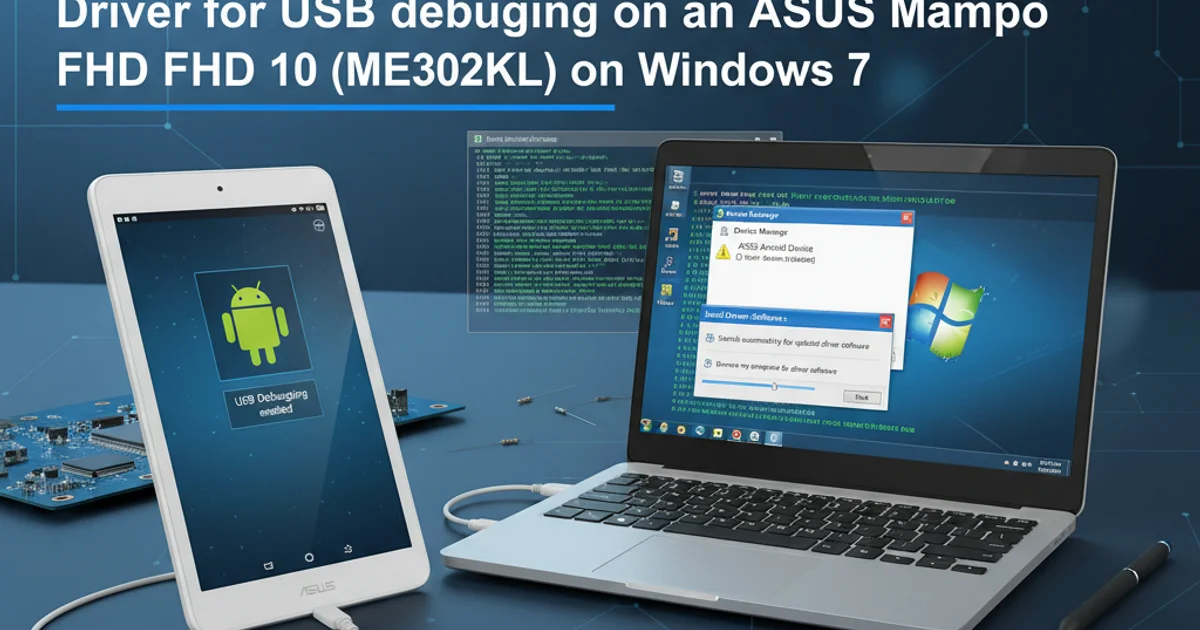Driver for USB debugging on an ASUS Memo Pad FHD 10 (ME302KL) on Windows 7
Categories:
Installing USB Debugging Drivers for ASUS Memo Pad FHD 10 (ME302KL) on Windows 7

A comprehensive guide to setting up USB debugging drivers for your ASUS Memo Pad FHD 10 (ME302KL) on a Windows 7 system, enabling seamless Android development and device interaction.
Enabling USB debugging on your Android device is a crucial step for developers, allowing you to install apps directly from your development environment, access device logs, and utilize various debugging tools. For the ASUS Memo Pad FHD 10 (ME302KL) on a Windows 7 operating system, this often requires specific driver installation to ensure proper communication between your tablet and PC. This article will guide you through the process, addressing common challenges and providing a clear path to successful driver setup.
Understanding USB Debugging and Drivers
USB debugging is a mode that allows an Android device to communicate with a computer using the Android Debug Bridge (ADB) command-line tool. This communication is essential for tasks like sideloading applications, running shell commands, and debugging applications in real-time. For your Windows 7 PC to recognize the ASUS Memo Pad FHD 10 in debugging mode, it needs the correct USB drivers. Without these drivers, your device might appear as an unknown device in Device Manager, or ADB commands will fail to recognize it.
flowchart TD
A[Enable USB Debugging on Tablet] --> B{Connect Tablet to PC}
B --> C{Windows 7 Detects Device}
C -->|Drivers Installed?| D[Device Manager: Check for 'Android Device' or 'ADB Interface']
C -->|No Drivers| E[Device Manager: 'Unknown Device' or 'Other Devices']
D --> F[ADB Works: `adb devices` lists tablet]
E --> G[Install ASUS USB Drivers]
G --> H[Update Driver in Device Manager]
H --> DFlowchart of USB Debugging Driver Installation Process
Prerequisites and Initial Setup
Before attempting to install the drivers, ensure your ASUS Memo Pad FHD 10 is properly configured for USB debugging. This involves enabling Developer Options and then toggling the USB debugging setting. You'll also need to download the necessary drivers. While Google provides generic ADB drivers, device-specific drivers from ASUS are often more reliable for their hardware.
1. Enable Developer Options
On your ASUS Memo Pad FHD 10, navigate to Settings > About tablet. Tap on 'Build number' seven times until a toast message appears stating 'You are now a developer!'
2. Enable USB Debugging
Go back to Settings, and you should now see a new option: Developer options. Tap on it, and then enable 'USB debugging' by toggling the switch. Confirm any prompts that appear.
3. Download ASUS USB Drivers
Visit the official ASUS support website for the ME302KL model. Look for the 'Driver & Utility' section, select 'Android' as the OS, and download the 'USB' driver package. Extract the downloaded ZIP file to an easily accessible location on your Windows 7 PC, such as C:\ASUS_USB_Drivers.
4. Connect Tablet to PC
Using a reliable USB cable, connect your ASUS Memo Pad FHD 10 to your Windows 7 computer. The tablet should prompt you to allow USB debugging from your computer's RSA key fingerprint. Always select 'Always allow from this computer' and tap 'OK'.
Manual Driver Installation on Windows 7
Windows 7 might not automatically find the correct drivers, even after connecting the device. In such cases, a manual installation through Device Manager is required. This process involves locating the unrecognized device and pointing Windows to the downloaded driver files.
1. Open Device Manager
Right-click on 'My Computer' or 'Computer' on your desktop or Start Menu, select 'Manage', and then click on 'Device Manager' in the left pane. Alternatively, type devmgmt.msc into the Run dialog (Win+R) and press Enter.
2. Locate the Unrecognized Device
In Device Manager, look for an entry under 'Other devices' or 'Portable Devices' that might be labeled as 'Unknown device', 'ME302KL', or 'Android'. It will typically have a yellow exclamation mark next to it, indicating a missing driver.
3. Update Driver Software
Right-click on the unrecognized device and select 'Update Driver Software...'. Choose 'Browse my computer for driver software'.
4. Specify Driver Location
Click 'Browse...' and navigate to the folder where you extracted the ASUS USB drivers (e.g., C:\ASUS_USB_Drivers). Ensure 'Include subfolders' is checked, then click 'Next'.
5. Complete Installation
Windows will now attempt to install the driver. If successful, you should see a confirmation message. The device entry in Device Manager should change to 'ASUS Android Device' or 'Android Composite ADB Interface' under 'Android Device' or 'ADB Interface'.
adb devices
Command to verify ADB device recognition
After successful driver installation, open a command prompt and type adb devices. Your ASUS Memo Pad FHD 10 (ME302KL) should now be listed with its serial number, indicating that USB debugging is active and working correctly.